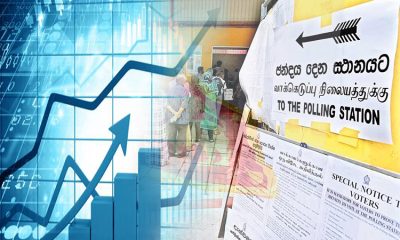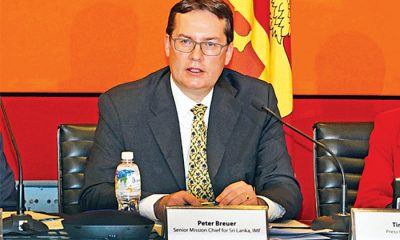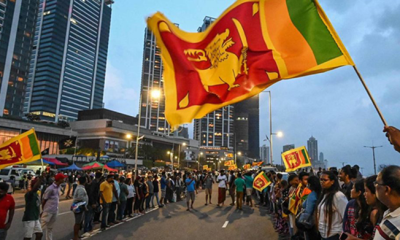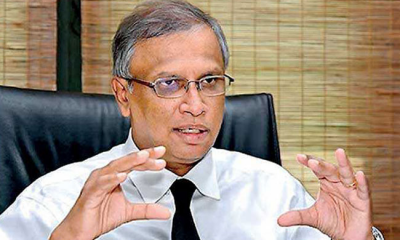Features
Energy, EVs, environment and economy

by M. Rizwan Muzzammil
According to an article in ‘The Diplomat’ (2nd Oct., 23), the Sri Lankan government has committed to supplying 70% of its domestic electricity, with renewable energy sources, by 2030, with the longer-term goal of achieving a fully renewable electricity supply by 2050. The government is incentivised by “debt-for-renewables swap”, which enables heavily indebted countries to restructure a portion of their external debt on to more favourable terms in exchange for environmental commitments.
In addition, a strong push is observed for fully electric vehicles (EVs) with incentives on offer.
In general, the public opinion on these environmental developments is likely to be positive. On a global level, the environment is a hot topic, with climate change, carbon dioxide emissions, EVs, and sustainable growth occupying the minds of many policy-makers.
It is now widely accepted that fossil fuels (oil, coal and natural gas) negatively impact the environment by causing climate change through carbon dioxide emissions.
For these reasons, renewable energies and achieving ‘net zero emissions,’ through EVs, is considered to be a top priority. This is required to happen even at the expense of economic growth, which is deemed to be detrimental for the Earth’s resources.
However, some research on this topic shows that the situation is more nuanced than what may first seem apparent. The author presents some arguments for the reader’s consideration and references material from the books ‘Fossil Future’ (2022) by Alex Epstein and ‘In Defense of Capitalism’ (2023) by Rainer Zitelmann. The reader is encouraged to refer to these books for more details.
Fossil fuels
In ‘Fossil Future’ Epstein, notes that cheap and reliable energy is needed to keep people warm when it is too cold, and cool when it is too warm. It is used to build shelter, to transport food and resources, for manufacturing and many other applications essential for human flourishing.
Fossil fuels are a cheap and reliable energy source and have been a major reason for the rapid development of economies around the world. As a direct result of fossil fuels large human populations have been saved from tremendous hardship, starvation and poverty.
Epstein points out that much of the present-day narrative on fossil fuels overly focuses on the negatives while ignoring the tremendous positives. Despite the efforts at improving renewable energy technologies, mainly solar and wind, they are still at present no substitute for fossil fuels as a cheap and reliable energy source.
Although climate change is a problem, fossil fuels can be used to protect, mitigate and adapt to its adverse effects, which are predicted to occur gradually over a manageable period of time.
EVs
The push for EVs is a substantial step from the now common semi-electric hybrids. Hybrid vehicles are a well-tested means of transport, and there is much experience in the market with regards to the repair and safety of such vehicles (the Prius is now in its 25th year). However, the problems related to the mass adoption of EVs are still not widely understood. Some examples are:
Due to the presence of the battery, EVs are about 30% heavier, compared to ordinary vehicles. In the event of a collision between an EV and ordinary vehicle, the latter is likely to suffer disproportionately more damage, and passengers more likely to be injured. In addition, multi-story carparks, bridges and highways may need to be reinforced to take on the increased vehicle weights.
Furthermore, EVs that have been involved in accidents can sustain damage to the battery. A chemical leak could result, leading to toxic contaminations and fires, requiring specialized equipment to manage. Emergency response units may need to be properly equipped to deal with such problems.
The charging of EVs may also require an upgrade to the electric grid and household wiring, so that higher electric loads can be handled. In the US State of California, gasoline cars are to be banned for sale by 2035. In order to manage the electric loads on the grid, consumers will be required to charge their vehicles only at certain times of the day. For a developing country like Sri Lanka managed charge times may prove to be a hindrance to economic growth.
Earth’s resources are finite
Many who are concerned about the environment believe that economic growth is problematic. This is because Earth’s raw materials are finite and therefore infinite growth is impossible.
In ‘In Defense of Capitalism’, Zitelmann points out that despite finite raw materials, the correlation between economic growth and resource consumption is becoming ever weaker in the modern era.
Companies are constantly looking for new ways to produce more efficiently with less raw materials. They do this not mainly to protect the environment but rather to cut costs and increase profit. The resulting innovation has promoted a trend called miniaturization.
Zitelmann gives the example of the smartphone, which has now replaced many devices. A basic smartphone now contains a calculator, telephone, video camera, alarm clock, voice recorder, navigation system, maps, camera, mp3 player (replacing cassette or CD player), compass, answering machine, scanner, measuring tape, radio, torch, calendar, encyclopedia, dictionary, foreign language dictionaries, address book, etc. Therefore, the answer to the limited resources problem is more complex than what seems obvious.
What does it really cost?
The push for renewables and EVs is a government initiative, i.e. a form of central planning, and not driven by free-markets. This push is incentivized or subsidized by taxpayer money. This implies that consumers in a free market would reject such solutions absent these incentives, as the true price would be unpalatable.
The masking of the true price is a concern for the general health of the economy. If we consider the general Sri Lankan economic crisis, it can be summed up by saying that the people did not know the true costs of what they consumed, either because it was taxpayer subsidized by debt and money printing (inflation), or the dollar value was manipulated by the Central Bank. Had they known the true cost it is entirely likely that Sri Lankans would have consumed within their means and the crisis never happened.
All government plans must happen by legislative incentives or subsidies. Despite the evils this is considered acceptable because it is widely believed the health of the environment cannot be left to free-markets.
But history informs us otherwise. Zitelmann points out that environmental degradation has been a far more serious problem in centrally planned countries. This despite these same countries often claiming (sometimes boastfully) the environment to be of primary importance.
The example of the Soviet Union
Consider the former USSR. In 1990, Zhores Medvedev noted: “The Soviet Union has lost more pasture and agricultural land to radioactive contamination than the total acreage of cultivated land in Switzerland. More land has been flooded by hydroelectric dams than the total area of Netherlands. More land was lost between 1960 and 1989 through salinization, changes in the water table, and dust and salt storms than the total areas of cultivated land in Ireland and Belgium put together. Amidst acute food shortages, the total acreage of cultivated land has declined by one million hectares a year since 1975. The Soviet Union is losing its forests at the same rate as rainforests are disappearing in Brazil.
In Uzbekistan and Moldavia, chemical poisoning with pesticides has led to such high rates of mental retardation that the educational curricula in secondary schools and universities have had to be modified and simplified.” In the book, Ecocide in the USSR (1992), Feshbach and Friendly Jr. say “no other industrial civilization so systematically and so long poisoned its land, air, and people.”
Private property as a solution
In general, countries which have socialist governments have often ended up with grossly mismanaged environments. Nearer to home India is a good example. The Sri Lankan environment also leaves much to be desired.
But why does this happen? Zitelmann, refers to the German economist Polleit, who states “By monopolizing legislation and jurisdiction, states have been the originators of many environmental problems:”For example, by allowing companies and consumers to dump pollutants on roads and into rivers, oceans, and the air at no cost. Often, this practice is justified on the basis of the ‘common good,’ which places the rights of polluters above the rights of the aggrieved (property owners). For example, owners of property located near an airport must endure increasing aircraft noise without being compensated by the airport operator.”
Thus, the problem occurs fundamentally due to property ownership, namely, the government being the owner and manager of natural resources, and doing a poor job of it due to the lack of market incentives.
A solution to this could be to privatise natural resources as far as possible. This could include land, roads, rivers and even ocean segments. Since the resources will have market value, the owners would be scrupulous in ensuring that they are in no way damaged by others. Anyone responsible for damaging property would be held accountable. Problems such as air and noise pollution could also be dealt with in this way.
A perfect solution is unlikely, but the protection of private property is a well understood concept and likely to yield better results compared to a government solution.
In fact, the most environmentally clean nations are those that are most economically free with more private property. Zitelmann reviews three research indexes: Yale University’s Environmental Performance Index (EPI), The Heritage Foundations ‘Index of Economic Freedom’ and the ‘Open Market Index’ (OMI) and finds close positive correlations between economic growth, free-markets and the environment.
Another study, ‘Is Free Trade Good for the Environment?’’ by Antweiler et al, found that if openness to international markets raises output and income by 1%, pollution concentrations fall by about 1%. The study goes on to say, “At an early stage of a country’s economic growth, a high level of environmental degradation is observed, while, after a critical point of economic growth, a gradual decline in environmental degradation is reported.”
Conclusions
The historical evidence and research show that a centrally planned approach to protecting the environment tends to backfire and not achieve intended goals. The Sri Lankan government could effect better outcomes by relaxing import controls to improve innovation (anyway upcoming), removing subsidies and incentives, and privatizing energy producers and other natural resources as much as possible. Sri Lankans could be better served by deciding for themselves what vehicle or energy or environment is best suited for their needs without incentives or subsidies.
The writer, a civil engineer, resides in Singapore. He can be reached on write2rizwan.m@gmail.com. His previous published articles can be viewed on rizwanmuzzammil.substack.com
Features
The heart-friendly health minister

by Dr Gotabhya Ranasinghe
Senior Consultant Cardiologist
National Hospital Sri Lanka
When we sought a meeting with Hon Dr. Ramesh Pathirana, Minister of Health, he graciously cleared his busy schedule to accommodate us. Renowned for his attentive listening and deep understanding, Minister Pathirana is dedicated to advancing the health sector. His openness and transparency exemplify the qualities of an exemplary politician and minister.
Dr. Palitha Mahipala, the current Health Secretary, demonstrates both commendable enthusiasm and unwavering support. This combination of attributes makes him a highly compatible colleague for the esteemed Minister of Health.
Our discussion centered on a project that has been in the works for the past 30 years, one that no other minister had managed to advance.
Minister Pathirana, however, recognized the project’s significance and its potential to revolutionize care for heart patients.
The project involves the construction of a state-of-the-art facility at the premises of the National Hospital Colombo. The project’s location within the premises of the National Hospital underscores its importance and relevance to the healthcare infrastructure of the nation.
This facility will include a cardiology building and a tertiary care center, equipped with the latest technology to handle and treat all types of heart-related conditions and surgeries.
Securing funding was a major milestone for this initiative. Minister Pathirana successfully obtained approval for a $40 billion loan from the Asian Development Bank. With the funding in place, the foundation stone is scheduled to be laid in September this year, and construction will begin in January 2025.
This project guarantees a consistent and uninterrupted supply of stents and related medications for heart patients. As a result, patients will have timely access to essential medical supplies during their treatment and recovery. By securing these critical resources, the project aims to enhance patient outcomes, minimize treatment delays, and maintain the highest standards of cardiac care.
Upon its fruition, this monumental building will serve as a beacon of hope and healing, symbolizing the unwavering dedication to improving patient outcomes and fostering a healthier society.We anticipate a future marked by significant progress and positive outcomes in Sri Lanka’s cardiovascular treatment landscape within the foreseeable timeframe.
Features
A LOVING TRIBUTE TO JESUIT FR. ALOYSIUS PIERIS ON HIS 90th BIRTHDAY

by Fr. Emmanuel Fernando, OMI
Jesuit Fr. Aloysius Pieris (affectionately called Fr. Aloy) celebrated his 90th birthday on April 9, 2024 and I, as the editor of our Oblate Journal, THE MISSIONARY OBLATE had gone to press by that time. Immediately I decided to publish an article, appreciating the untiring selfless services he continues to offer for inter-Faith dialogue, the renewal of the Catholic Church, his concern for the poor and the suffering Sri Lankan masses and to me, the present writer.
It was in 1988, when I was appointed Director of the Oblate Scholastics at Ampitiya by the then Oblate Provincial Fr. Anselm Silva, that I came to know Fr. Aloy more closely. Knowing well his expertise in matters spiritual, theological, Indological and pastoral, and with the collaborative spirit of my companion-formators, our Oblate Scholastics were sent to Tulana, the Research and Encounter Centre, Kelaniya, of which he is the Founder-Director, for ‘exposure-programmes’ on matters spiritual, biblical, theological and pastoral. Some of these dimensions according to my view and that of my companion-formators, were not available at the National Seminary, Ampitiya.
Ever since that time, our Oblate formators/ accompaniers at the Oblate Scholasticate, Ampitiya , have continued to send our Oblate Scholastics to Tulana Centre for deepening their insights and convictions regarding matters needed to serve the people in today’s context. Fr. Aloy also had tried very enthusiastically with the Oblate team headed by Frs. Oswald Firth and Clement Waidyasekara to begin a Theologate, directed by the Religious Congregations in Sri Lanka, for the contextual formation/ accompaniment of their members. It should very well be a desired goal of the Leaders / Provincials of the Religious Congregations.
Besides being a formator/accompanier at the Oblate Scholasticate, I was entrusted also with the task of editing and publishing our Oblate journal, ‘The Missionary Oblate’. To maintain the quality of the journal I continue to depend on Fr. Aloy for his thought-provoking and stimulating articles on Biblical Spirituality, Biblical Theology and Ecclesiology. I am very grateful to him for his generous assistance. Of late, his writings on renewal of the Church, initiated by Pope St. John XX111 and continued by Pope Francis through the Synodal path, published in our Oblate journal, enable our readers to focus their attention also on the needed renewal in the Catholic Church in Sri Lanka. Fr. Aloy appreciated very much the Synodal path adopted by the Jesuit Pope Francis for the renewal of the Church, rooted very much on prayerful discernment. In my Religious and presbyteral life, Fr.Aloy continues to be my spiritual animator / guide and ongoing formator / acccompanier.
Fr. Aloysius Pieris, BA Hons (Lond), LPh (SHC, India), STL (PFT, Naples), PhD (SLU/VC), ThD (Tilburg), D.Ltt (KU), has been one of the eminent Asian theologians well recognized internationally and one who has lectured and held visiting chairs in many universities both in the West and in the East. Many members of Religious Congregations from Asian countries have benefited from his lectures and guidance in the East Asian Pastoral Institute (EAPI) in Manila, Philippines. He had been a Theologian consulted by the Federation of Asian Bishops’ Conferences for many years. During his professorship at the Gregorian University in Rome, he was called to be a member of a special group of advisers on other religions consulted by Pope Paul VI.
Fr. Aloy is the author of more than 30 books and well over 500 Research Papers. Some of his books and articles have been translated and published in several countries. Among those books, one can find the following: 1) The Genesis of an Asian Theology of Liberation (An Autobiographical Excursus on the Art of Theologising in Asia, 2) An Asian Theology of Liberation, 3) Providential Timeliness of Vatican 11 (a long-overdue halt to a scandalous millennium, 4) Give Vatican 11 a chance, 5) Leadership in the Church, 6) Relishing our faith in working for justice (Themes for study and discussion), 7) A Message meant mainly, not exclusively for Jesuits (Background information necessary for helping Francis renew the Church), 8) Lent in Lanka (Reflections and Resolutions, 9) Love meets wisdom (A Christian Experience of Buddhism, 10) Fire and Water 11) God’s Reign for God’s poor, 12) Our Unhiddden Agenda (How we Jesuits work, pray and form our men). He is also the Editor of two journals, Vagdevi, Journal of Religious Reflection and Dialogue, New Series.
Fr. Aloy has a BA in Pali and Sanskrit from the University of London and a Ph.D in Buddhist Philosophy from the University of Sri Lankan, Vidyodaya Campus. On Nov. 23, 2019, he was awarded the prestigious honorary Doctorate of Literature (D.Litt) by the Chancellor of the University of Kelaniya, the Most Venerable Welamitiyawe Dharmakirthi Sri Kusala Dhamma Thera.
Fr. Aloy continues to be a promoter of Gospel values and virtues. Justice as a constitutive dimension of love and social concern for the downtrodden masses are very much noted in his life and work. He had very much appreciated the commitment of the late Fr. Joseph (Joe) Fernando, the National Director of the Social and Economic Centre (SEDEC) for the poor.
In Sri Lanka, a few religious Congregations – the Good Shepherd Sisters, the Christian Brothers, the Marist Brothers and the Oblates – have invited him to animate their members especially during their Provincial Congresses, Chapters and International Conferences. The mainline Christian Churches also have sought his advice and followed his seminars. I, for one, regret very much, that the Sri Lankan authorities of the Catholic Church –today’s Hierarchy—- have not sought Fr.
Aloy’s expertise for the renewal of the Catholic Church in Sri Lanka and thus have not benefited from the immense store of wisdom and insight that he can offer to our local Church while the Sri Lankan bishops who governed the Catholic church in the immediate aftermath of the Second Vatican Council (Edmund Fernando OMI, Anthony de Saram, Leo Nanayakkara OSB, Frank Marcus Fernando, Paul Perera,) visited him and consulted him on many matters. Among the Tamil Bishops, Bishop Rayappu Joseph was keeping close contact with him and Bishop J. Deogupillai hosted him and his team visiting him after the horrible Black July massacre of Tamils.
Features
A fairy tale, success or debacle

Sri Lanka-Singapore Free Trade Agreement
By Gomi Senadhira
senadhiragomi@gmail.com
“You might tell fairy tales, but the progress of a country cannot be achieved through such narratives. A country cannot be developed by making false promises. The country moved backward because of the electoral promises made by political parties throughout time. We have witnessed that the ultimate result of this is the country becoming bankrupt. Unfortunately, many segments of the population have not come to realize this yet.” – President Ranil Wickremesinghe, 2024 Budget speech
Any Sri Lankan would agree with the above words of President Wickremesinghe on the false promises our politicians and officials make and the fairy tales they narrate which bankrupted this country. So, to understand this, let’s look at one such fairy tale with lots of false promises; Ranil Wickremesinghe’s greatest achievement in the area of international trade and investment promotion during the Yahapalana period, Sri Lanka-Singapore Free Trade Agreement (SLSFTA).
It is appropriate and timely to do it now as Finance Minister Wickremesinghe has just presented to parliament a bill on the National Policy on Economic Transformation which includes the establishment of an Office for International Trade and the Sri Lanka Institute of Economics and International Trade.
Was SLSFTA a “Cleverly negotiated Free Trade Agreement” as stated by the (former) Minister of Development Strategies and International Trade Malik Samarawickrama during the Parliamentary Debate on the SLSFTA in July 2018, or a colossal blunder covered up with lies, false promises, and fairy tales? After SLSFTA was signed there were a number of fairy tales published on this agreement by the Ministry of Development Strategies and International, Institute of Policy Studies, and others.
However, for this article, I would like to limit my comments to the speech by Minister Samarawickrama during the Parliamentary Debate, and the two most important areas in the agreement which were covered up with lies, fairy tales, and false promises, namely: revenue loss for Sri Lanka and Investment from Singapore. On the other important area, “Waste products dumping” I do not want to comment here as I have written extensively on the issue.
1. The revenue loss
During the Parliamentary Debate in July 2018, Minister Samarawickrama stated “…. let me reiterate that this FTA with Singapore has been very cleverly negotiated by us…. The liberalisation programme under this FTA has been carefully designed to have the least impact on domestic industry and revenue collection. We have included all revenue sensitive items in the negative list of items which will not be subject to removal of tariff. Therefore, 97.8% revenue from Customs duty is protected. Our tariff liberalisation will take place over a period of 12-15 years! In fact, the revenue earned through tariffs on goods imported from Singapore last year was Rs. 35 billion.
The revenue loss for over the next 15 years due to the FTA is only Rs. 733 million– which when annualised, on average, is just Rs. 51 million. That is just 0.14% per year! So anyone who claims the Singapore FTA causes revenue loss to the Government cannot do basic arithmetic! Mr. Speaker, in conclusion, I call on my fellow members of this House – don’t mislead the public with baseless criticism that is not grounded in facts. Don’t look at petty politics and use these issues for your own political survival.”
I was surprised to read the minister’s speech because an article published in January 2018 in “The Straits Times“, based on information released by the Singaporean Negotiators stated, “…. With the FTA, tariff savings for Singapore exports are estimated to hit $10 million annually“.
As the annual tariff savings (that is the revenue loss for Sri Lanka) calculated by the Singaporean Negotiators, Singaporean $ 10 million (Sri Lankan rupees 1,200 million in 2018) was way above the rupees’ 733 million revenue loss for 15 years estimated by the Sri Lankan negotiators, it was clear to any observer that one of the parties to the agreement had not done the basic arithmetic!
Six years later, according to a report published by “The Morning” newspaper, speaking at the Committee on Public Finance (COPF) on 7th May 2024, Mr Samarawickrama’s chief trade negotiator K.J. Weerasinghehad had admitted “…. that forecasted revenue loss for the Government of Sri Lanka through the Singapore FTA is Rs. 450 million in 2023 and Rs. 1.3 billion in 2024.”
If these numbers are correct, as tariff liberalisation under the SLSFTA has just started, we will pass Rs 2 billion very soon. Then, the question is how Sri Lanka’s trade negotiators made such a colossal blunder. Didn’t they do their basic arithmetic? If they didn’t know how to do basic arithmetic they should have at least done their basic readings. For example, the headline of the article published in The Straits Times in January 2018 was “Singapore, Sri Lanka sign FTA, annual savings of $10m expected”.
Anyway, as Sri Lanka’s chief negotiator reiterated at the COPF meeting that “…. since 99% of the tariffs in Singapore have zero rates of duty, Sri Lanka has agreed on 80% tariff liberalisation over a period of 15 years while expecting Singapore investments to address the imbalance in trade,” let’s turn towards investment.
Investment from Singapore
In July 2018, speaking during the Parliamentary Debate on the FTA this is what Minister Malik Samarawickrama stated on investment from Singapore, “Already, thanks to this FTA, in just the past two-and-a-half months since the agreement came into effect we have received a proposal from Singapore for investment amounting to $ 14.8 billion in an oil refinery for export of petroleum products. In addition, we have proposals for a steel manufacturing plant for exports ($ 1 billion investment), flour milling plant ($ 50 million), sugar refinery ($ 200 million). This adds up to more than $ 16.05 billion in the pipeline on these projects alone.
And all of these projects will create thousands of more jobs for our people. In principle approval has already been granted by the BOI and the investors are awaiting the release of land the environmental approvals to commence the project.
I request the Opposition and those with vested interests to change their narrow-minded thinking and join us to develop our country. We must always look at what is best for the whole community, not just the few who may oppose. We owe it to our people to courageously take decisions that will change their lives for the better.”
According to the media report I quoted earlier, speaking at the Committee on Public Finance (COPF) Chief Negotiator Weerasinghe has admitted that Sri Lanka was not happy with overall Singapore investments that have come in the past few years in return for the trade liberalisation under the Singapore-Sri Lanka Free Trade Agreement. He has added that between 2021 and 2023 the total investment from Singapore had been around $162 million!
What happened to those projects worth $16 billion negotiated, thanks to the SLSFTA, in just the two-and-a-half months after the agreement came into effect and approved by the BOI? I do not know about the steel manufacturing plant for exports ($ 1 billion investment), flour milling plant ($ 50 million) and sugar refinery ($ 200 million).
However, story of the multibillion-dollar investment in the Petroleum Refinery unfolded in a manner that would qualify it as the best fairy tale with false promises presented by our politicians and the officials, prior to 2019 elections.
Though many Sri Lankans got to know, through the media which repeatedly highlighted a plethora of issues surrounding the project and the questionable credentials of the Singaporean investor, the construction work on the Mirrijiwela Oil Refinery along with the cement factory began on the24th of March 2019 with a bang and Minister Ranil Wickremesinghe and his ministers along with the foreign and local dignitaries laid the foundation stones.
That was few months before the 2019 Presidential elections. Inaugurating the construction work Prime Minister Ranil Wickremesinghe said the projects will create thousands of job opportunities in the area and surrounding districts.
The oil refinery, which was to be built over 200 acres of land, with the capacity to refine 200,000 barrels of crude oil per day, was to generate US$7 billion of exports and create 1,500 direct and 3,000 indirect jobs. The construction of the refinery was to be completed in 44 months. Four years later, in August 2023 the Cabinet of Ministers approved the proposal presented by President Ranil Wickremesinghe to cancel the agreement with the investors of the refinery as the project has not been implemented! Can they explain to the country how much money was wasted to produce that fairy tale?
It is obvious that the President, ministers, and officials had made huge blunders and had deliberately misled the public and the parliament on the revenue loss and potential investment from SLSFTA with fairy tales and false promises.
As the president himself said, a country cannot be developed by making false promises or with fairy tales and these false promises and fairy tales had bankrupted the country. “Unfortunately, many segments of the population have not come to realize this yet”.
(The writer, a specialist and an activist on trade and development issues . )
























